Choosing between a Dutch oven and a braiser is tough since these two pieces of cookware seem to be similar in function and versatility. Well, we are here to help you decide. In this article, we will compare the braiser vs. Dutch oven.
What is a Braiser?
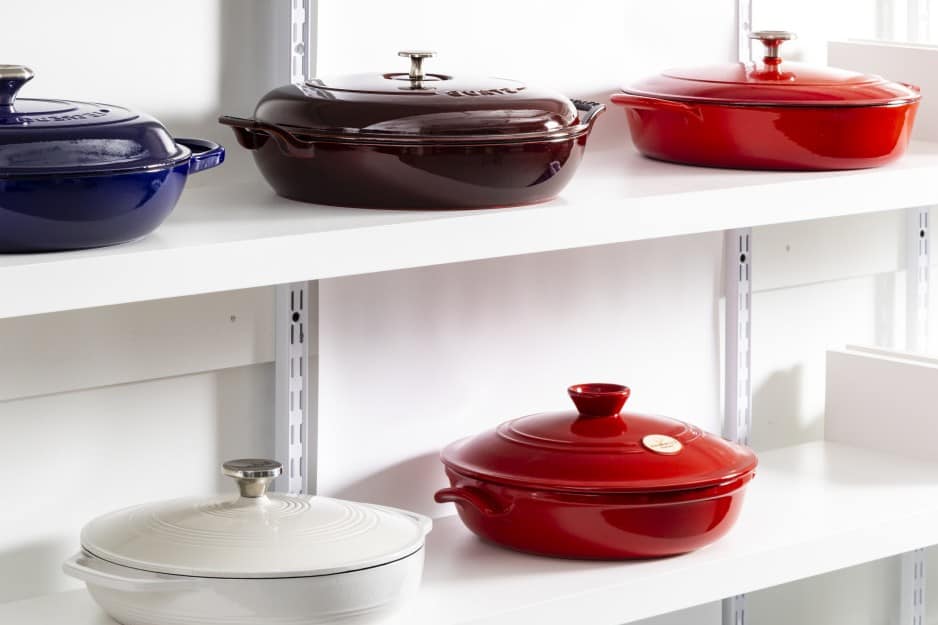
The braiser is cookware that has both the functions of pot and pan. Like the Dutch oven, it’s also made with cast iron, ceramic, or aluminum. The surface is either seasoned or enameled.
True to its name, the primary function of the braiser is to braise the food. Searing and simmering are other functions of the braiser. The braising process will result in very tender and juicy meat and vegetables. Additionally, the sauce you cook in the braiser is intensely flavored.
| Braiser Scenario | Recipe Ideas |
|---|---|
| Searing meats | Braised Beef Short Ribs |
| Cooking with little liquid | Chicken with White Wine & Garlic |
| Shallow frying | Pan-fried Sea Bass |
| Cooking large cuts of meat | Braised Pork Shoulder |
| One-pan meals | Braised Chicken with Vegetables |
| Low and slow cooking | Tomato and Red Wine Braised Lamb |
| Vegetables and sides | Braised Fennel with Citrus |
| Simmering sauces | Red Wine Reduction Sauce |
Dutch Oven Demystified
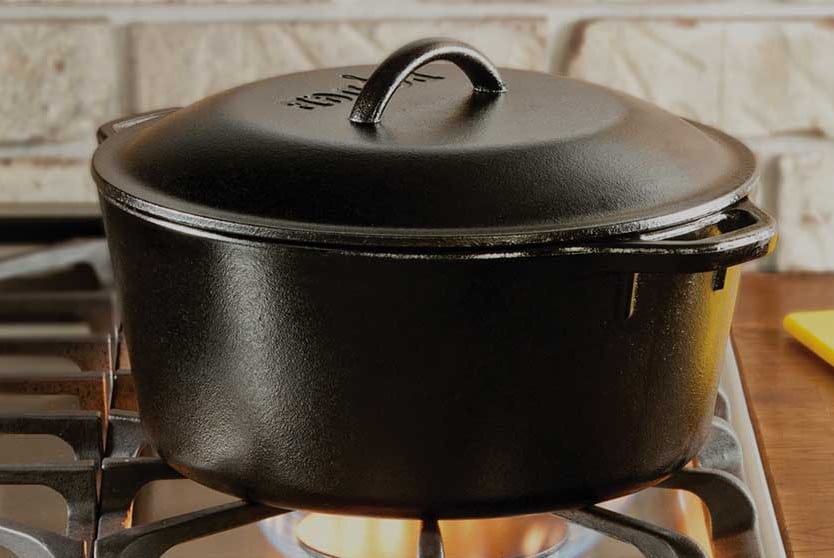
To better know which cookware is suitable for you, let’s understand its functions first. The first one is the Dutch oven.
A Dutch oven is a type of cooking pot known for its thick and deep walls with tight lids. They are often made with cast iron, aluminum, or ceramic. The surface of the Dutch oven is often seasoned or lined with enamel.
The Dutch oven is commonly utilized for dishes that need a slow cooking process. Roasts, stews, and soup are typically cooked in Dutch ovens since they need to be tenderized for a long time. Since the Dutch oven has the word oven in its name, you might be wondering: Can you bake in a Dutch oven?
The answer is yes! There are several side dishes and baked goods you can use the Dutch oven for, such as pizza and roasted potatoes.
| Dutch Oven Scenario | Recipe Ideas |
|---|---|
| Slow-cooked stews | Beef Bourguignon with carrots and red wine |
| Baking | No-knead crusty bread |
| Deep frying | Homemade doughnuts |
| One-pot meals | Chicken and rice with vegetables |
| Soup | Creamy tomato basil soup |
| Roasting | Pot roast with root vegetables |
| Braising | Red wine braised short ribs |
| Casseroles | Dutch oven lasagna |
| Desserts | Dutch oven peach cobbler |
| Camping outdoors | Campfire chili with beans and ground beef |
Difference in Size and Appearance
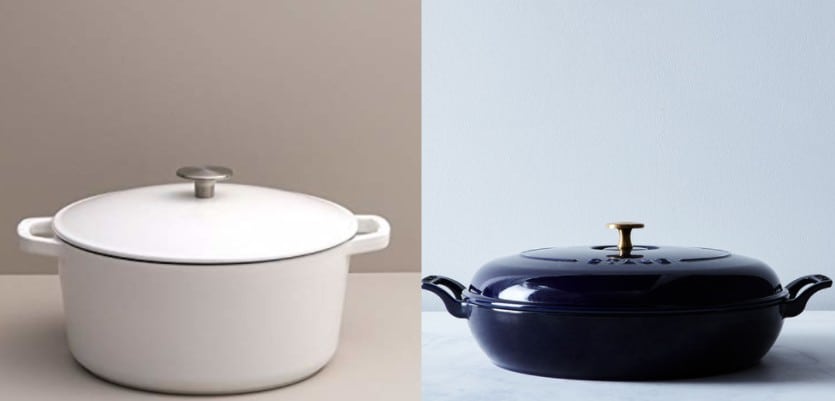
One of the primary differences you can see instantly is the size of the cookware. The braiser has shallow walls and a broader surface than the Dutch oven.
The best way to differentiate the two is to look at their appearance. The Dutch oven looks like a standard kitchen pot, while the braiser is more of a cross between a pot and a pan.
Since the Dutch oven is larger, designed for bigger meals such as stew and braised whole chicken, it requires more working space.
On the other hand, the braiser is designed for simmering and braising, processes that don’t need a deep space. The braiser has a wider surface, perfect for equal cooking and heat distribution.
Functional Differences and Similarities
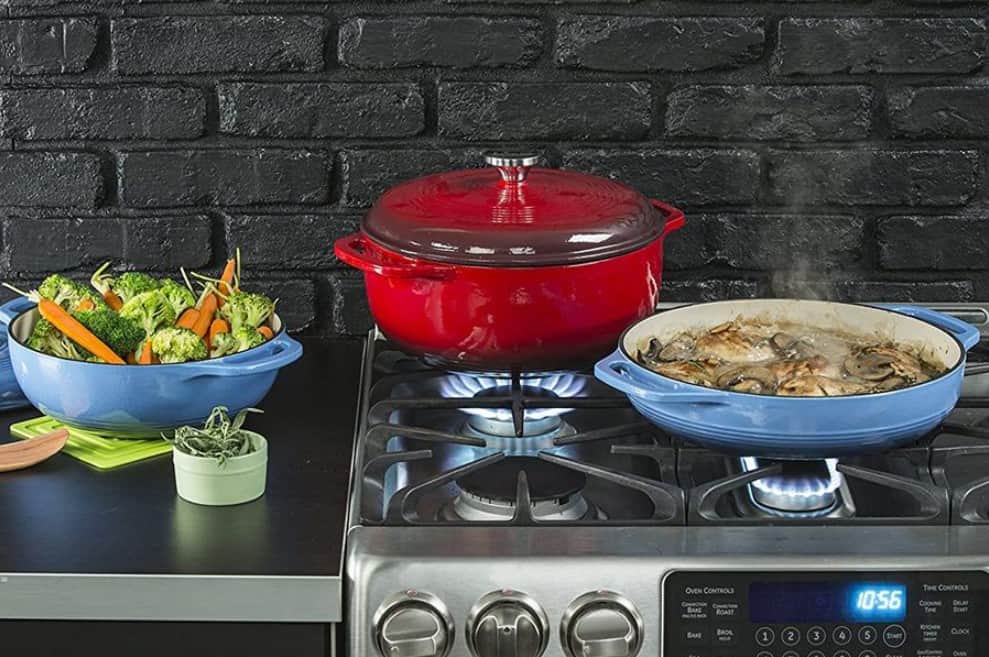
Although you can sometimes use the two cookware interchangeably, there are some functions that you can get from one but not on the other. Don’t fret! We will explain it all to you.
Simmering
You can use both of the cookware for simmering. The only thing you have to look out for is the size of the pot. You can use the braiser if you want cookware that can heat up quickly and make smaller servings. On the other hand, the dutch oven is a lot slower to preheat. You can use the dutch oven for larger portions.
Baking
One of the notable differences between the dutch oven and braiser is the baking feature of the dutch oven. You can bake roasted potatoes and sourdough bread with the dutch oven due to its tight lid.
Searing
Technically, you can sear with both cookware. The only disadvantage you can encounter when using a dutch oven is its deeper walls. If searing is one of the primary functions you want from your cookware, you can opt for a braiser instead.
Stews and Soups
If you want to cook a stew or soup, the dutch oven is the perfect cookware for you. The tight lid can trap the heat for a long time. Dutch ovens also have deeper walls, perfect for stirring stew and soups. Although, you can also make a stew with a braiser. One of the downsides is that it’s more shallow. The small size also doesn’t retain heat well.
Preheating and Heat Distribution
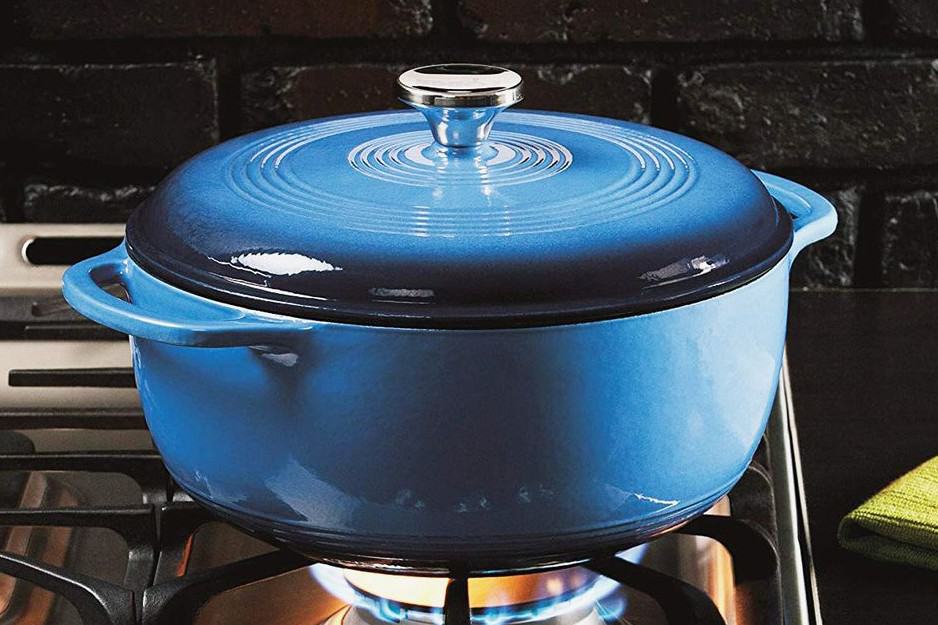
Although the braiser and Dutch oven are made with similar materials, there are some differences in their heat distribution.
The braiser is much faster to preheat than the Dutch oven due to its smaller size, and braisers distribute heat more evenly than a Dutch oven.
If you want longer heat retention, the Dutch oven can help you with that. The tight lid and larger size will help keep the heat longer.
Which One Should You Choose?
Depending on your needs, you should know which option is better for you. We are here to help you with that decision.
Serving Size
One of the features you might need to keep in mind when choosing between a braiser and a Dutch oven is the serving size.
If you have a larger family that calls for bigger batches of food, you should opt for a Dutch oven. Dutch ovens fit parties or gatherings where you need an enormous amount of food.
Braisers are perfect for small to medium-sized servings. If you want to cook for a family of five, for example, the space will suffice.

Everyday Use for the Cookware
When choosing cookware, make sure to identify the uses you will need it for. Are you going to use it for cooking stew? Roast?
Do you want cookware you can use for parties, gatherings, or camping?
Although you can use both interchangeably for many cooking processes, you need to find the cookware that will satisfy your needs.
| Use | Braiser | Dutch Oven |
|---|---|---|
| Browning/Searing | Excellent for even browning | Possible, deeper walls can hinder |
| Slow Cooking | Suitable for less liquid | Ideal with deep walls |
| Baking | Not typical | Great for bread, cakes, pizzas |
| Stews/Soups | Good for smaller batches | Perfect for longer durations |
| Simmering | Quick heating | Good for larger portions |
| Roasting | Suitable for smaller roasts | Ideal for larger roasts |
| Heat Retention | Decent | Excellent |
| Preheating Time | Quick | Longer due to size |
Storage Capabilities
The storage capabilities are another factor when buying your cookware. Dutch oven requires more storage space since it’s not advisable to hang it on a pot rail.
On the other hand, the braiser can be hung on a railing or pegboard. The smaller size of the braiser makes it much easier to carry and store. If you have limited space in your apartment or frequently relocate, owning a large pot like a Dutch oven might not be suitable for you.
Tips for Using a Braiser and Dutch Oven
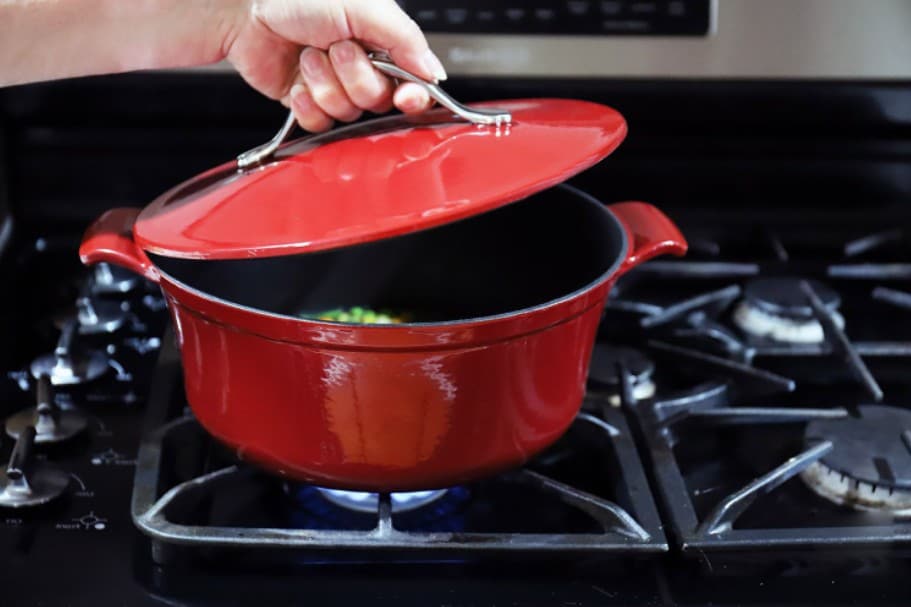
Preheat the Cookware
Before using either of the two, you should always preheat it. Preheating helps the pan to distribute the heat more evenly.
It also prevents hot spots when cooking. A hot spot is when an area in the pan is much hotter than the area surrounding it. The uneven distribution of heat will ruin the meat and veggies when you sear or sauté.
Be sure to put the braiser or Dutch oven on medium heat for about 3-5 minutes before cooking.
Proper Storage
Always make sure to dry your braiser or Dutch oven before storing. The moisture can cause rusting and damage to your pan.
To ensure your cookware is dry, you can either heat it up on the stove or dry it in the oven.
Avoid Using Metal Utensils
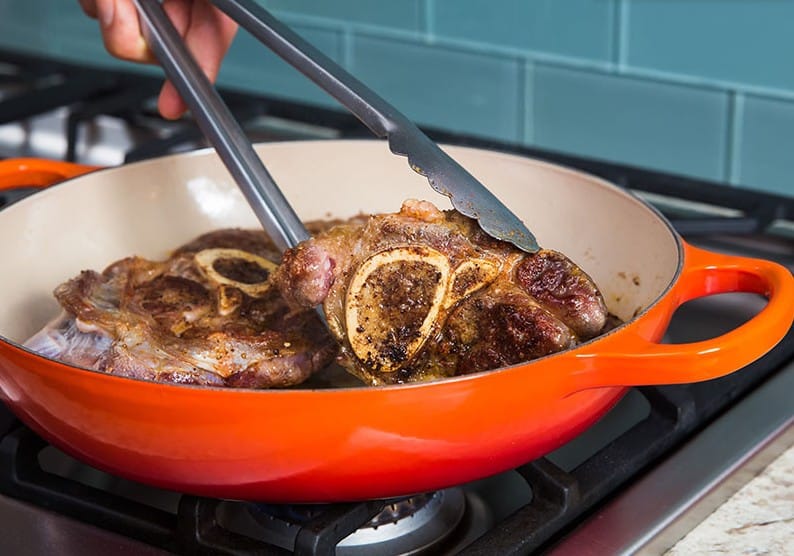
Although traditional braisers and Dutch ovens are not prone to scratches, the modern enameled ones are.
Be sure to use wooden, silicone, or bamboo utensils when cooking. Using non-abrasive utensils will limit the scratches and damage in the enamel coating of your cookware.
Reseason Regularly
Braisers and dutch pans can last a lifetime. Since they are made with cast iron, they are very durable and not prone to damage.
Most modern braisers and dutch ovens don’t require seasoning since they are lined with enamel. On the other hand, old models need to be reseasoned to keep them from being damaged.
Reseasoning is a necessary process to prolong the life of your dutch oven and braisers. This process will protect your cookware from rust and moisture. It will also keep a non-stick finish, perfect for easier cleaning and cooking.
To do this process, you need:
- Aluminum Foil
- Soap
- Pig Lard or Vegetable Oil
- Sponge
Method:
- Gently scrub the braiser or Dutch oven with a sponge and soapy water.
- Crumple up the aluminum foil and scrub off the rust as much as you can. The abrasive surface of the aluminum foil can help you remove the rust and any debris sticking in your cookware.
- Once all of the dirt or rust is removed, place your cookware on the stove. Turn the stove into the highest setting. Let all of the moisture dry off completely before putting in oil.
- Use a paper or fabric towel to spread the oil on your pan. Let the pan absorb the oil before turning off the heat.
- Rub oil again before putting it in the oven for 400 degrees Fahrenheit.
That’s it! Your Dutch oven or braiser is finally reseasoned. You should do this process every 1-2 months to properly protect your cookware.
If you want a non-stick finish, repeat the process 3-5 times to create a thicker oil coating.
In Conclusion
Braisers and Dutch ovens might be similar in hindsight, but like any other cookware, they have their differences and similarities. We hope this article helps you differentiate between a braiser and a Dutch oven.


Michael Johnson is the founder of Pan Mastery, Inspired by his blacksmith grandfather’s legacy has a deep appreciation for hand-crafted pots and pans, he provides invaluable guides, reviews, and recipes to enhance your culinary journey.
